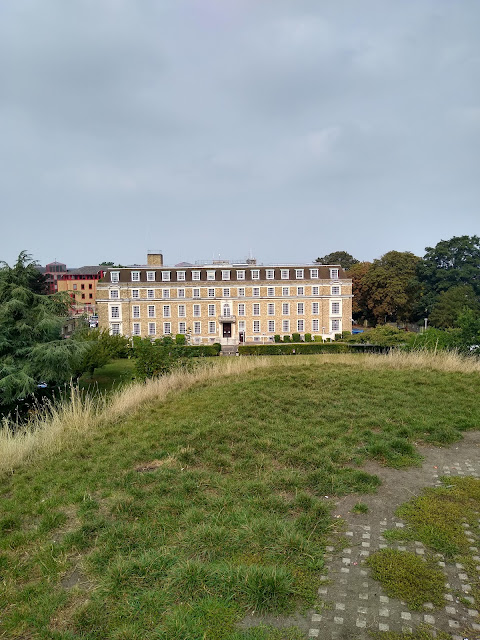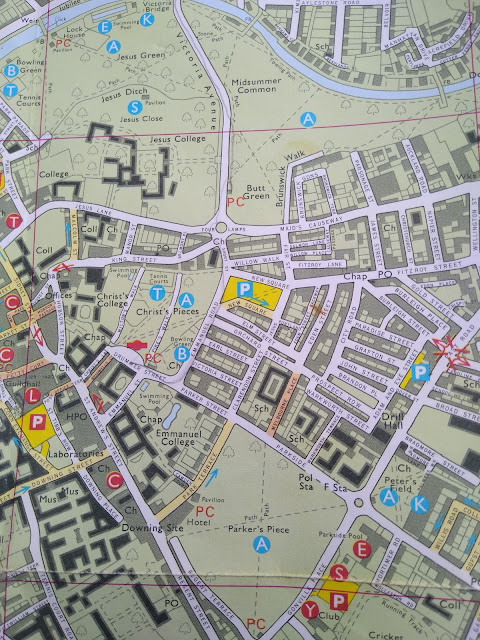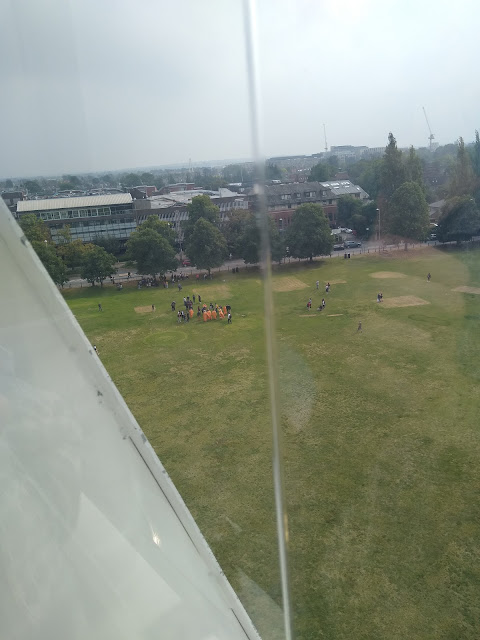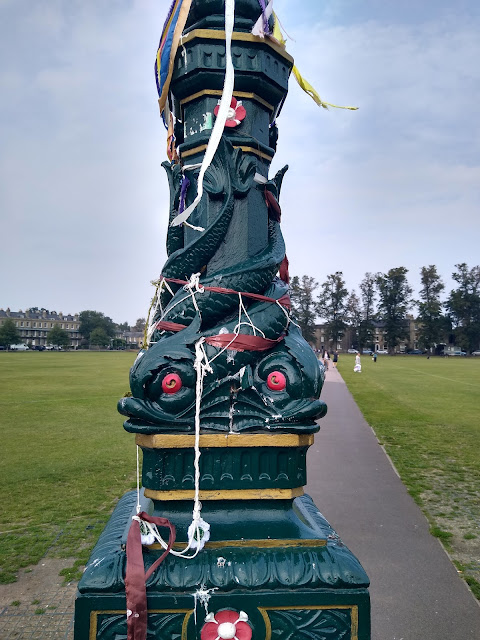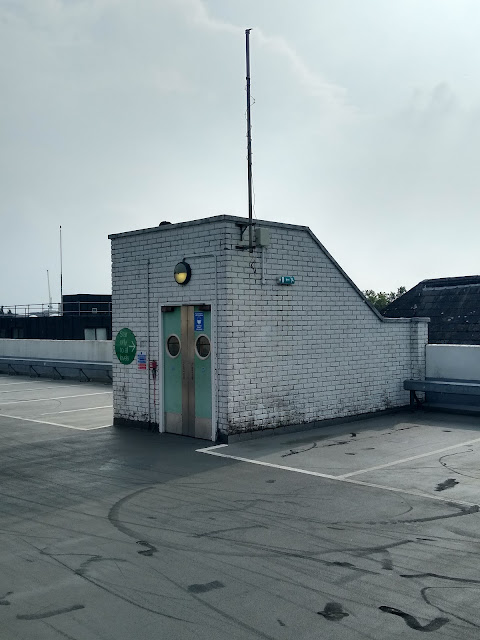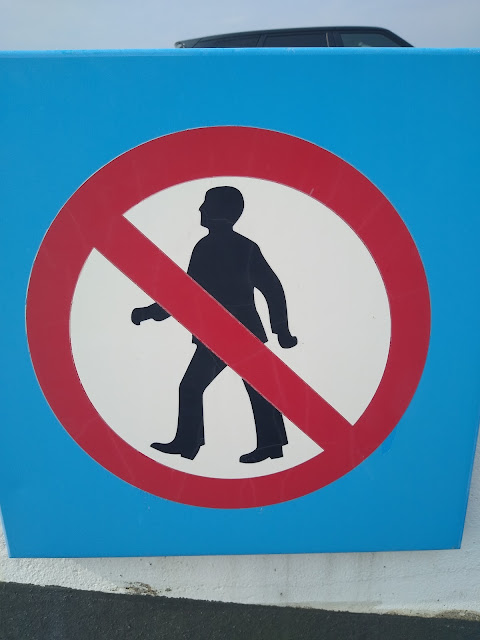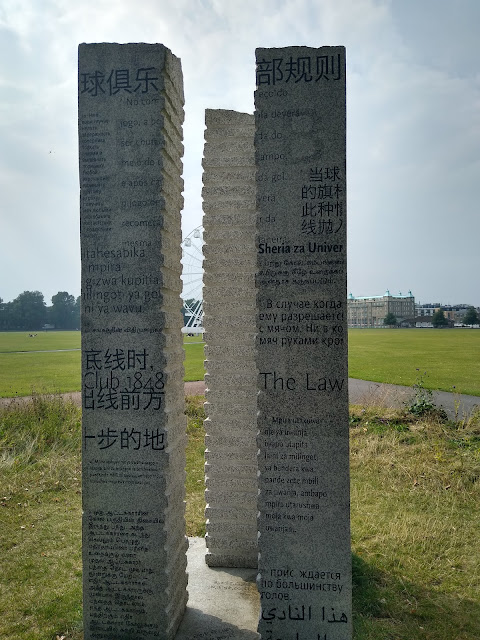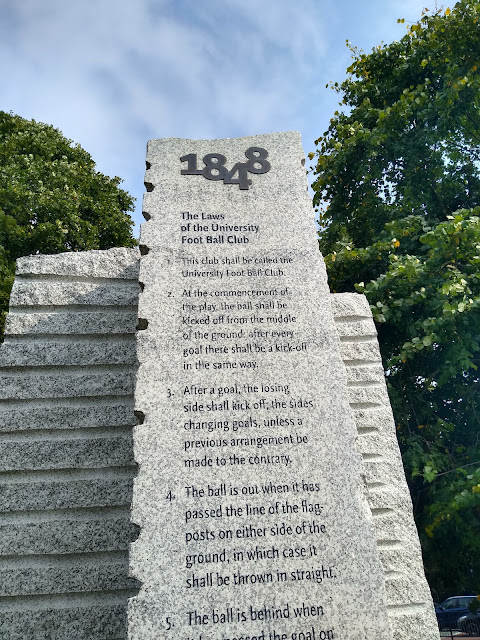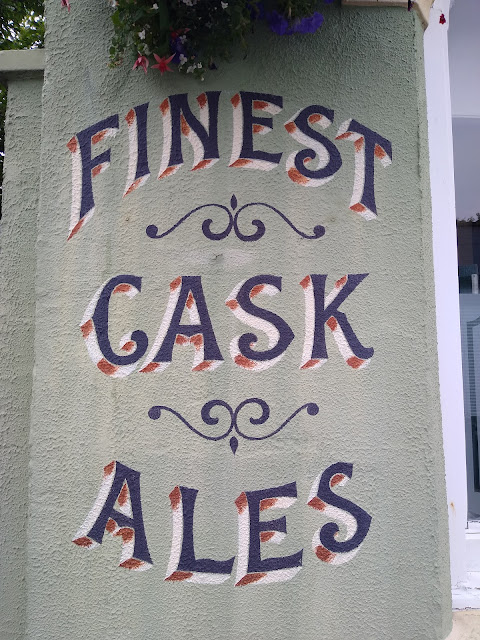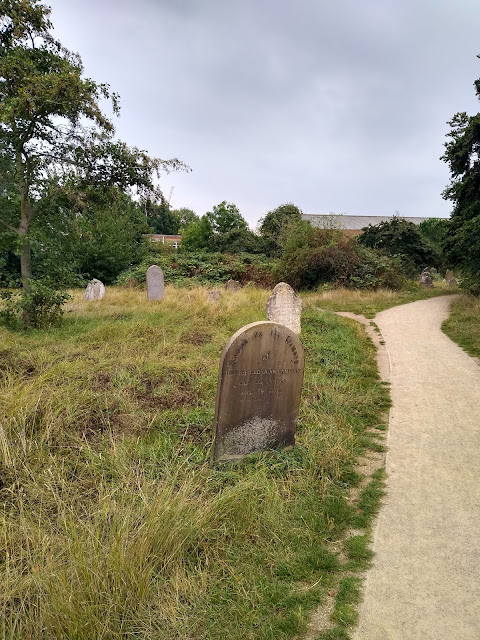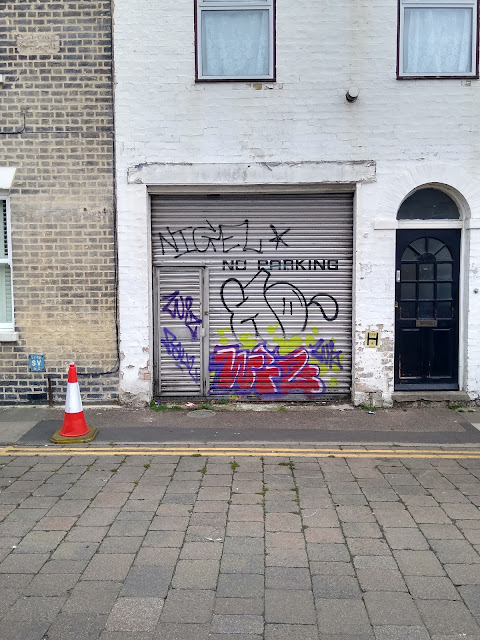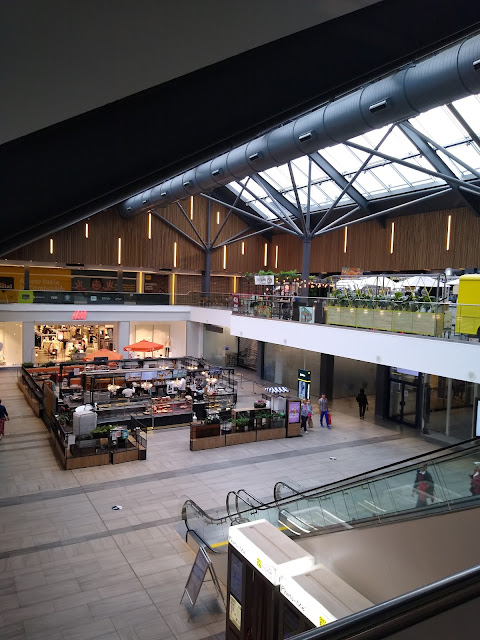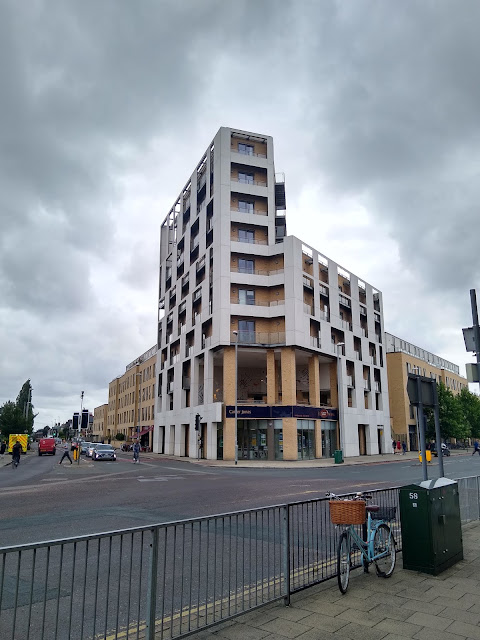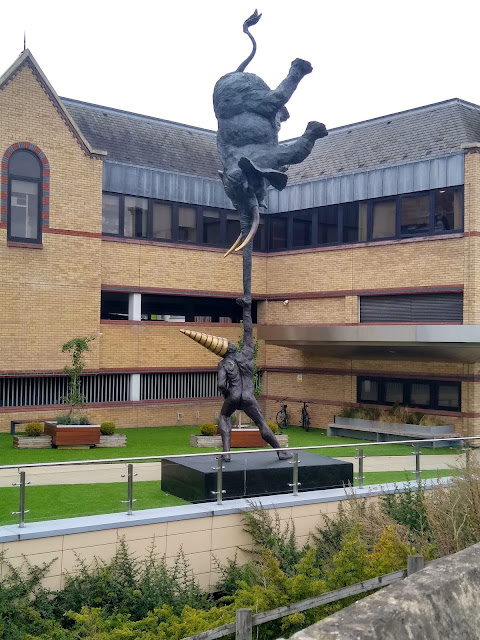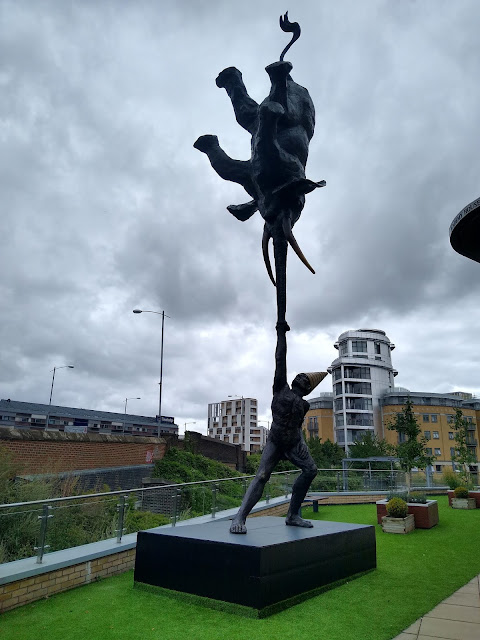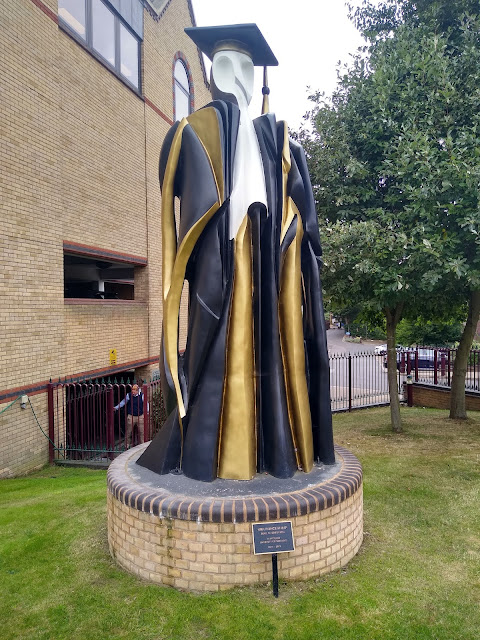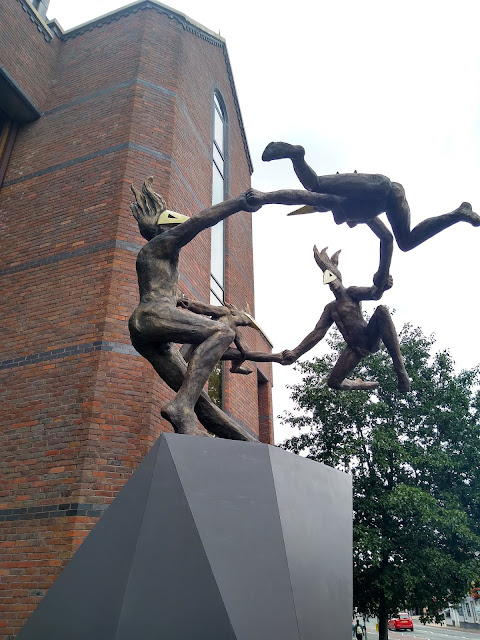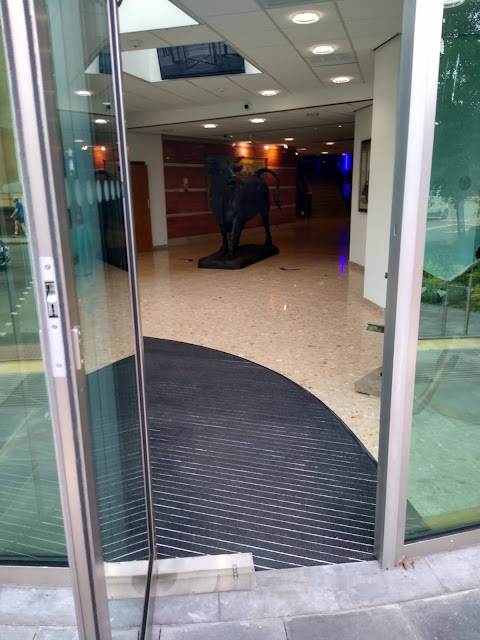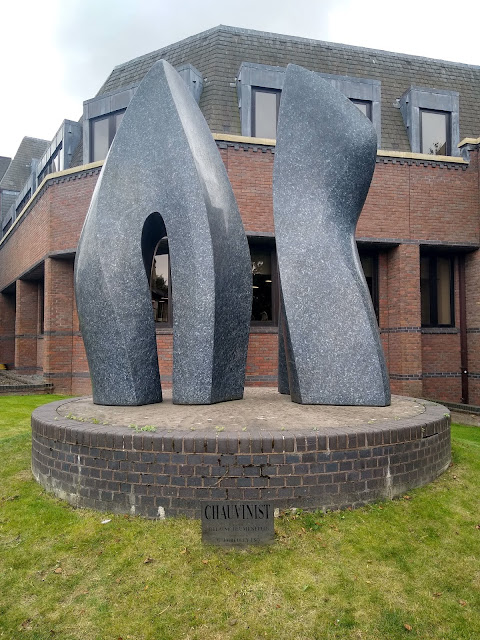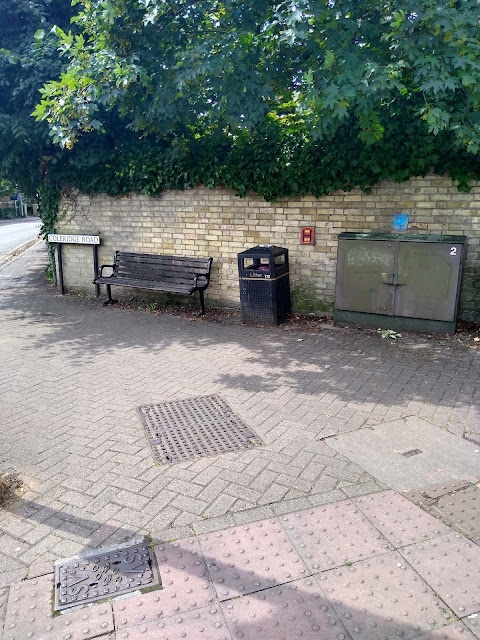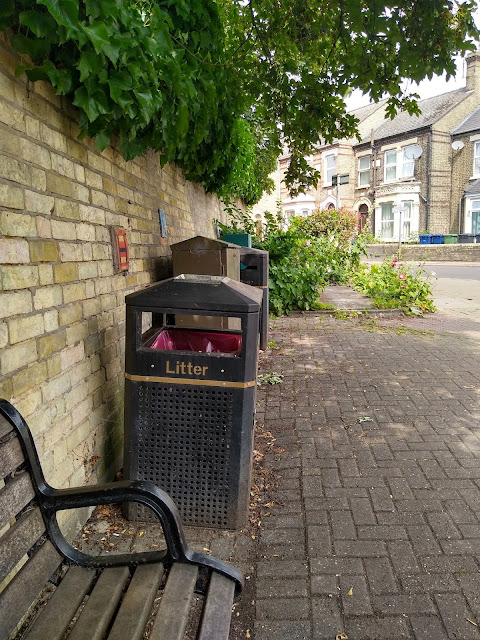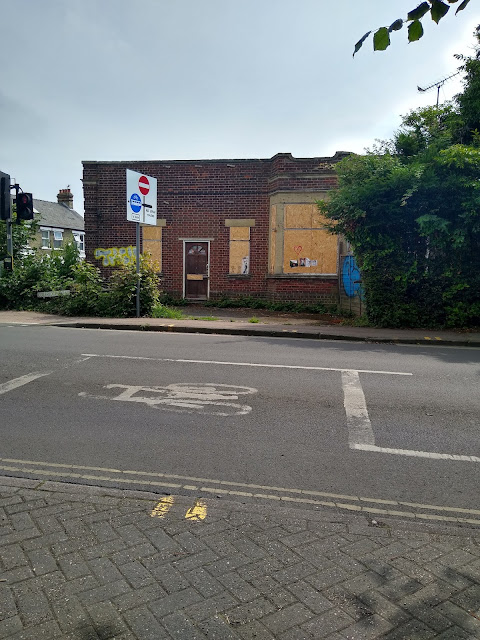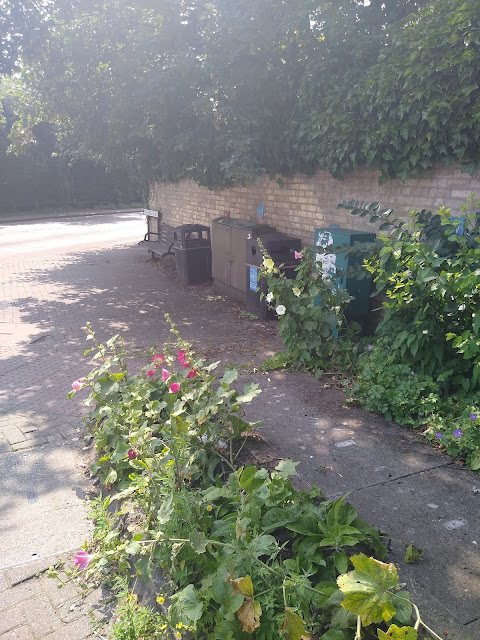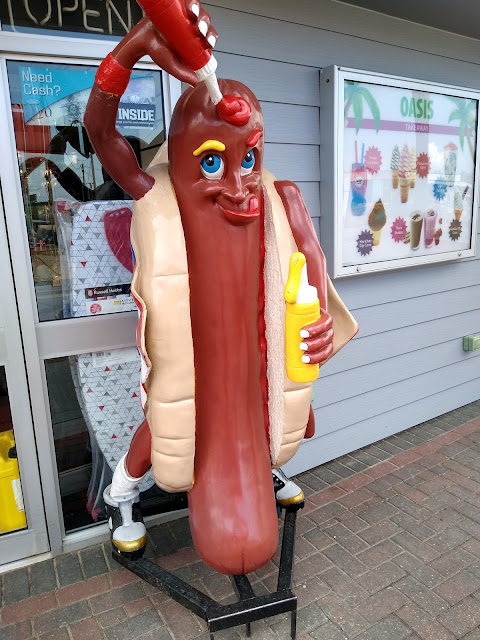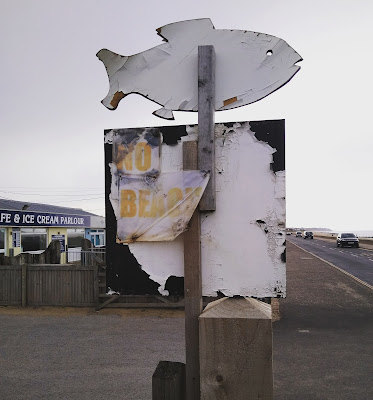Preamble
In an attempt to further reduce the digital burden, I
acquired some dice to replace random number generator websites. The first roll
of these new analogue catapults decreed that I would go grid square G7. This
square, located to the North East of the city centre, contains most of the suburb
of Chesterton, an area that had been developed during the 1930s and the post
war period for municipal and council housing. The parish of Chesterton was
administratively subsumed into Cambridge in the early 20th century
as the former agricultural land, around what had been a village, was developed.
To the North West of G7, Milton Road severs Chesterton from an area mostly unbuilt
on and showing as a green space at the time of the 1980 map.
The Chesterton part of the map covered an area I was fairly
familiar with, at least in part. But it was the streets I had no recollection
of having ever been down, or in some cases never heard of at all, that
intrigued me the most. I was familiar with Scotland Road, but not so much the
streets that branched off from it. In particular, the cluster of streets named
after places north of the border were an unknown quantity. Edinburgh Road,
Inverness Close and Stirling Close were only barely on the periphery of my
mental map. I wondered, what was the Scottish connection? North of these
streets the map depicts an allotment. This space was a blind spot in my mental
geography of Cambridge. I wondered if the allotments were still there or had
been lost to development in the intervening years. Further to the North, in a corner between
Milton Road and Green End Road, the map depicts a recreation ground. This was
another blind spot. Despite having cycled along the adjacent Green end Road
countless times, I had never noticed any entrance to any rec.
In the North Western part of the grid square, somewhere in
the large green space that stretched behind the back gardens of houses on, was the
site of a former anthrax burial. The map shows an athletics track creeping into
square C7 at the western extremity of this space, likely party of the Manor
secondary school playing fields. I knew
that most of this green area was now largely covered by houses and flats. A
friend told me he had heard some travellers were evicted from the site at some
point before this, the anthrax contamination being cited by the authorities as
making it unsafe for them to stay. Shortly afterwards, the new housing estate
was built. The depiction of this area on the map as a largely featureless green
space and these possibly unreliable snippets of its history sparked my
imagination.
Amble
I crossed the border into Grid Square G7 at the confluence
of Water Lane, Water Street and Fallowfield. Fallowfield is the name of a
street and the residential area in its immediate environs that was first
developed as ‘assisted’ housing in the 1930s. Presumably the space was one of
the fields of Chesterton prior to its development. I had vague memories of
visiting the area in the 1990s to house parties once or twice. But so vague
that when I passed the cheery floral sign, reminiscent of something from a
1970s primary school, I may as well have been stepping across the border into a
different time and space.

The street was familiar yet unfamiliar. Superficially, I
could have been in a late 1930s municipal suburb of any town. But there was a
particular atmosphere permeating from the houses, grass verges, passages and
front garden paraphernalia that comprised the physical environment. It was
something peculiar to Chesterton, in particular the part developed in the late
1930s as municipal housing that I had (must have) felt before. It probably harked
back to my earliest memories of Chesterton as a small boy, when visiting my uncle,
aunt and cousins who lived on Cam Causeway.
Where the road split in each direction and circled around
some houses on a sort of large residential roundabout, I took the longest arc,
passing a profusion of front gardens and some newer residential developments
mixed in with the older houses. Soon I came to a dead end (for drivers) where
there was a car park, strictly for residents. For the pedestrian, there was a
passage leading to Franks Lane, a street I had never been down. The crack along the middle of the asphalt of the first half of the passage made it look like an underground watercourse was straining to get through and would soon be successful.

The short distance through the passage was enough to
disorientate me. As I stepped out of the other end, I mistakenly thought I’d emerged
into Cam Causeway. Such was the similarity to the street my cousins used to
live in. I realised after checking the map, that Cam Causeway ran parallel,
just beyond the back gardens of the houses I now faced. I walked down the end
of Franks Lane to find another passage, one shown on the map connecting the two
streets. I was pleased to find it still existed, but I did not pass beyond the
post that marked both the passage entrance and the boundary between grid
squares. At this point I realised that the festival of Terminalia, God of
Boundaries and Borders, was the following day. From that point the walk took on
a different dimension. The various borders, boundaries and landmarks I passed
by all made their presence felt, as if they were ‘manifestations’ of Terminus.
I decided to mark the occasion early since work the next day would interfere
with any proper attempt to do so. I say I decided, but it felt as if the
various physically inanimate boundary markers and landmarks I encountered along
the way were semi-sentient guides that compelled me to notice them above all
else.

I doubled back and turned out of Franks Lane to walk along
the edge of a recreation ground, one I recalled playing with my cousins on in a
time of Witches Hats, concrete floors and a large disused steam roller (or
possibly a mock-up one) put out to pasture for kids to play on. These items, if
they really had ever existed, had long gone to make way for less dangerous
looking replacements.
I emerged into Cam Causeway and headed towards another area
I had often passed by but never explored, just beyond Green End Road. A metal
post displayed the proclamation ‘Do Not Ride Cycles on This Footpath’. It appeared
tree-like, grown out of a small ragged tuft of grass at its base and the
surrounding crumbling asphalt. The amalgam of notice and barrier stood like a
checkpoint, separating the (probably only just) pre-1980 map housing estate that
was immediately beyond. I passed through this portal and found myself
instantaneously transported into another zone.

Just beyond, I found myself in a small open space between
the houses that contained two concrete looking benches at opposite sides. They
were colonised with glowing yellow lichen, and on closer inspection, I
discovered, were actually wooden rather than concrete. The small estate seemed
deserted and was silent. I detected no sounds emanating from the small houses
that surrounded me. The benches resembled artifacts frozen in time, as if
colonised by the lichen after a period of prolonged disuse, following some sort
of low-key cataclysm. Another large green area was just across the way,
breaking up the buildings. It offered no passage beyond to anywhere else and
existed seemingly because it was necessary for its own sake and to offer an
uneven but benevolent grass respite for the residents of the estate.

The path took me in the opposite direction, and to an area
of three storey flats that I had no idea existed here. These gave way to
Maitland Avenue, one of two streets that ran North. These were lined with the
familiar type of brown post war municipal housing. Emerging from the end of the
street, I took a left turn to investigate a passage that was shown on the 1980
map as leading to the Nuffield Road Industrial Estate. The passage was still
there, just beyond the border of the map square. The entrance was marked by
three posts. The stumpy concrete one was flanked by two taller and metal
accomplices. An ambassador of Terminus, it marked the border between the
residential and industrial and also (roughly) the boundary of the grid square.
There was no question of passing beyond this concrete sentry. I almost unconsciously turned back to continue
my exploration of the grid square that I had been allocated, as if gently but
firmly encouraged to do so by the aging concrete post.

I soon found myself back on Green End Road, the main route
out of Chesterton at this end of the suburb. I crossed over in search of the rec
shown on the map, apparently located somewhere behind the houses on the other
side of the road. A couple of large posts caught my eye and drew me towards
them. Closer, I found they marked the entrance to a roadway between two houses.
They looked like they ought to be supporting a huge gate, but instead there was
an insubstantial and open metal barrier on each side. At the top of each post
was a screen-like square, which I supposed might house a CCTV camera or some
other security monitoring device. A sign indicated that the Browns Field
Community Centre lie ahead. Looking at the map, the site of the rec ought to be
somewhere in the same direction, so I passed between the posts to see what was beyond.

Behind the houses the space opened up into a small liminal
zone. A place of uneven asphalt with scrubby grass at the edges, it was home to
a skip, a possibly abandoned car trailer and an unceremoniously dumped shopping
trolly. The latter was in a space behind some semi-aged concrete posts, as if
being either protected or imprisoned by them.

I paused in the space for a moment. There was no sight or
sound of anyone, although I stood behind several houses and their back gardens.
Though the asphalt and brick-like path to one side of it were clearly
relatively recent additions, I felt like I was standing in a zone that had been
undisturbed for some time and one rarely visited. As I looked back, the main
focus in the open space was the skip, which seemed to mark disposal of whatever
had gone before and the interval preceding what was to come. At the beginning
of the end of the Covid era, I wasn’t certain whether to take this as an
optimistic sign that improvement was on the horizon. Or, if instead, it
signified something more ambiguous about the disposal not just of lockdowns and
restrictions, but many of the things previously taken for granted in the ‘old
normal’ pre Covid and pre-Brexit era.

I left the ambiguous space and crossed onto a path that ran
alongside the community centre on one side and a sloping greenspace on the
other. A mother and toddler son occupied a bench at the edge of the space, so I
didn’t feel comfortable invading their space to wander into the greenspace to
explore. I stuck to the path and carried on through the zone that must have
been the space previously occupied on the 1980 map.
‘A History of Browns Field Site by Derek Stubbings’ reveals
that the space I found myself in had previously been part of the much larger
Browns Field. This was one of several fields that surrounded Green end Road
until the area was developed in the 1920s and 1930s. It was named after the
owners, the family Brown, and was also known as ‘the pit’. The family
presumably benefitted when the site was dug up to extract sand and gravel.
After that, it was left to grow over, and eventually was surrounded by houses.
In the intervening period before the Community Centre was built in 2005, it was
used unofficially by children as a playground. I imagined a place resembling
the Spinney in Cherry Hinton or the area beyond the Scouts Field I had visited
in Harpenden. The sort of unofficial space where nature was left to its own
devices, unmanaged by The Wildlife Trust or Natural England. A place where nettles
and brambles were allowed to thrive, providing an attractive environment for
discarded mopeds, hedgerow porn and other detritus left by casual fly-tippers.
A public information film warning area, much more attractive to kids than any
official rec or nature reserve, if less so to dog walkers, nature enthusiasts
and anxious parents. Derek Brown makes no reference to an official rec. I
wondered if the area ever actually became ‘official’, with slides and
roundabouts replacing the wilderness. Or perhaps the ‘unofficial’ use was
recognised by the cartographer alone, who had decided to give the space some
‘official’ recognition when preparing the map in an attempt to retain it as a
space for kids to play on in the future.
Next to the community centre was Browns Filed ‘Pump Track’. It
resembled a BMX track concentrated into a small space. Pump tracks by contrast are apparently used by
‘pumping’- generating momentum by body movement rather than peddling or pushing
the bike. This brought back dim memories of the Sandy Banks BMX Track which
used to be located the other side of Chesterton near the river. Sandy Banks was
at least semi-unofficial, some of the kids who used it claiming to have built
it themselves on the apparently abandoned land. Another potential public
information film nightmare that it is hard to imagine being allowed to happen
now.
The path turned into yet another passage soon after the pump
track and I left the remains of Browns Field behind.
Emerging into a street I could see behind the houses a green
topped tower rising above in the near distance. I had noticed this before on
various bike rides but never seen it up close. I was drawn towards it but there
was no obvious throughway ahead. I was forced to follow the road.
I lost sight of it for a minute of two before it re-emerged,
slightly larger but still inaccessible.
The street deposited me onto Scotland Road, which Green end
Road morphs into somewhere around the rec near Cam Causeway. Here I was
distracted by a small route the other side of the road. It led me to a car park
behind some flats. A pair of signs, close to each other but both exactly the same,
were keen to discourage fly-tipping near the bins.
While successful at keeping the immediate space in front of
them clear, in the adjacent area just to the right a small gathering of
detritus, including a mattress and a group of traffic cones, appeared to mock
the pair of signs and their attempt at authority.
I doubled back and headed along Scotland road to resume my
quest for the tower. It came into view sporadically as I searched for the next
turning towards it. Eventually, I arrived at the turning into Ashfield Road, which
was marked by another green topped church building. This one was low key in comparison to the
tower, but still stood out as a landmark. The bizarre octagonal design and
striking pale green roof made the structure resemble something that hand landed
or been beamed down rather than built. Only the beige brick and white UPVC
window frames and panels betrayed its earthly origins.

I followed Ashfield road, presumably built upon yet another
one of the old fields of Chesterton. It was lined with brown municipal type
housing found in many of these streets. The generously sized front gardens
provided a varied display of use. My favourite one featured a slightly bumpy
and not overly manicured lawn peppered with purple crocus flowers. The least
impressive were the gardens mainly converted into gravel drives for the parking
of one or more cars. This street, and most of the others in the grid square
were made up of similar municipal housing (or in many cases former municipal
housing). Through a contemporary lens it seems almost unimaginable that
dwellings of this type could ever be built here, or indeed anywhere, for the
benefit of ordinary people for council rents. The generous front and back
gardens, as well as inner proportions of these dwellings, make more recently
built houses look laughable. I imagined
what the area would be like had the fields of Chesterton been acquired only
recently by developers of contemporary homes. The walk would have been very
different and probably crocus free. I tried not to think about it, and instead
enjoyed the pre-right-to-buy atmosphere that permeated from the houses and
gardens. No doubt many of the houses were now private and had been for years.
But the bricks and mortar spoke of an earlier era of municipality, one that
predated the current epoch of encouraging house price and home ownership
obsessiveness above all else.
I reached a crossroads. In one direction was Eastfields,
another field street! The other way was a cul-de-sac which, although featured
on the 1980 map, contained much more recent looking housing and little else.
Straight ahead was a short pedestrian and cycle path that led into Warren Road.
I was welcomed to this portal by another discarded shopping trolley, this time
with some passengers on board. A water butt and the remains of a bicycle were
yet more ambassadors of Terminus, marking the border between zones.
I left behind the ghosts of municipality as I stepped into
Warren Road, a street lined with 1930s semis, grass verges and trees. The trees
were wearing colourful woollen bands, having been the beneficiaries of a yarn
bombing. This seemed in keeping with the atmosphere which had changed to one of
1970s sit-com housing ubiquity and homogeneity, as a certain type of tranquil
but uneventful Sunday afternoon suburban anywhere-ness pervaded.

Not far along, a passage turned off to the left. The
decision to turn into it was almost involuntary. Chesterton seemed to be
blessed with a healthy number of back passages and short cuts for the
pedestrian. This one followed the length of back gardens from Warren Street and
the parallel Chesterfield Road. At the entrance stood another shopping trolley
and half way down between back gardens an electricity substation, behind a
wooden gate marked with the familiar ‘danger of death’ symbol. I encountered no
one but could hear voices from one of the back gardens beyond the just audible
hum of the substation. The space was a hybrid of the liminal and the suburban.

I emerged into Chesterfield Road which was almost
indistinguishable from Warren Road. That is until I reached St Georges Church,
the source of the green-topped tower I had seen earlier. The building was of a
similar vintage to the houses that surrounded it. The tower was as impressive
close up as it was from a distance. The distinctive pale green top was a beacon
that marked a spot just off the centre of the grid square. A focal point of G7
and a surveyor of everything within the square’s border.

Near the bottom of the tower, a statue of St George stood
upon a plinth within an alcove, the slain dragons head at his feet. The
medieval image was in stark contrast with the 1930s built church and its
surroundings, which included a flat roofed church hall that in part resembled a
1960s school science block. Thankfully there was no sign of the sort of
right-wing nationalism that has sought to claim St George as its own symbol
over recent years. The statue remained silent and enigmatic, facing West but
with eyes closed. I considered if this might be an avatar of Terminus, marking
the spot at the epicentre of Grid Square G7.
After a brief loiter at the base of the tower, I left the
scene, passing a modernist house with a green tiled roof and a flat roofed
extension with Crittall windows. Around the corner, between this and the more
run-of-the-mill semi next door, the tower once more made an appearance, the
statue facing me directly as if sending me on my way.

I continued along the rest of Fraser Road to emerge onto
Milton Road. I decided to head East to junction with Green End Road and Kings
Hedges Road. This marked a point along the northern border of the grid square,
which cut across the top of the junction. I felt the walk would be incomplete
without a visit to this landmark and boundary. In in 1980, according to the
map, the junction had been a roundabout rather than the current traffic light
system. I stood at the barrier that separated the road and the pedestrian
asphalt in front of the Co-op and looked across to the map border. Just beyond
it stood the Golden Hind, a 1930s Tolly Folly. The impressive, almost castle
like brown building features a clock tower with a pale green spire, emerging
from behind the rooves and chimney stacks. A boozy relation to the church spire
of St Georges, marking closing and opening times. The pub has a large car park
and dates from the age of the ‘roadhouse’, when large pubs on arterial roads away
from main city centres became popular destinations as car use became more
popular. This was a time when the dangers of drinking and driving hadn’t been
fully thought through. The Tolly Brewery
in Ipswich built several similar pubs, mainly in Ipswich itself. One of the
Ipswich follies is also named the Golden Hind, a place I had encountered on my Ipswich
Town Map walk. Thus, the landmark I was looking at was not only a
significant border marker in relation to the grid square. It was also a portal
back in time space, linking to Ipswich and its namesake folly there, the period
of their construction in the 1930s and to my excursion using the Ipswich map,
part of the same series as the Cambridge 1980 map I was using now.
I crossed Milton Road and headed back in the opposite
direction then turned into Ramsden Square. Built as municipal housing and
dating from the same period as that in Chesterton, it featured on the map adjacent
to the green area containing the anthrax burial ground. Rather than following
the road around the square, I followed a passage that led into an open green
space. This was a small surrounded by houses and back garden fences on all
sides. There was nobody else there and no sound from any of the nearby houses.
The otherwise empty space was occupied by a lone football goal. Beside it a small stretch of a grey metal
fence of the type normally used as barriers between pavements and busy roads
seemed to represent another boundary, but seemingly anomalously placed and with
no clear purpose. A mysterious site for another manifestation of Terminus to
make an appearance.

After a brief pause, I followed the only other exit from the
rec. The narrow passage pointing East cut between two back gardens, one with a
precariously leaning fence. I had to lean too in order to pass.
East was the direction I wanted to go in, to get to the
former green area on the map and see if any traces of the anthrax burial ground
still existed. But the road took me North briefly until a passage provided the
first opportunity of escape from Ramsden Square. A small grey post stood at the
entrance, a discarded empty fizzy drink can at its base. Another border
guardian.
I was deposited into Campkin Road, at the bottom end of the
Kings Hedges Estate, a vast (for Cambridge) amalgam of houses and flats mostly
built at various stages between the 1960s and
1980s. I headed East, realising that I had just breached the border of
G7, but that the way back South of the gridline was not far away, down a shared
cycle and footpath that lay between some flats and an old people’s home.
This route took me to Woodhead Drive, a street that
horizontally bisected the housing estate now covering the green area on the map.
Directly opposite was a building that initially looked like a large bungalow or
small old people’s home but on closer inspection was clearly neither of these
things. There were large steel devices fixed to the walls that looked like
extractor fans put on the wrong way around and red windowless doors that looked
impossible to open. A low-level hum emanated from the building and the space
around the back was blocked off by metal gates. After a few moments of bafflement,
I spotted s sign for BT Openreach, and realised it was one of their (possibly
unstaffed) outposts.

I headed East into the housing estate that was made up of
typically Barratt-style housing, probably dating from the 1990s. This featured
a confusing array of pointless cul-de-sac dead ends and a physical dividing
barrier between at least two parts of the estate, meaning that the only way to
cross was via Woodhead Drive. There was no way out onto Milton Road and no sign
of the athletics track that I assumed had been swallowed up by the estate. A
look at the current OS map seemed to confirm this. I headed back to the BT Openreach building,
at the same time underwhelmed and confused by the estate. On the way back I
encountered two comparatively large green spaces, one behind some houses/flats
and one making up a green ‘square’ buffering some of the houses from Woodhead
Drive. Both these green spaces were minor hillocks, resembling burial mounds
and unusually uneven. It seemed odd that the developers would not have wanted
to cram more houses in rather than allow such an expanse of green space. I
wondered if these were sites where anthrax infested horses and cattle had been
buried prior to the development. But more likely the planning permission
decreed some green space. This was a few years ago after all. I surmised that
the uneven surfaces were probably accounted for by the burial of unwanted plant
and building materials by the developers, a sort of construction industry
unmarked grave being the cheapest option for disposal.

Later internet ‘research’ produced a few clues to the former
anthrax site. Minutes of a Cambridge City Council Development Control Forum in 2003,
concerning development of George Nuttall Close, off Woodhead Drive, mention that the ‘issues of the risk of exposure to anthrax and radioactivity
had been thoroughly researched and dealt with’. It went on to confirm that ‘the
University would own the land where the anthrax infected carcasses were thought
to have been buried’ (my emphasis) and that ‘there was no radiation above
background levels’. The specific site subject to the planning application was
that of the former ‘Dunn Nutritional Unit’ buildings, a name that immediately
brings to mind the sort of remote ramshackle light industrial complex often
found in episodes of Dr Who and The Avengers and where secret Government
activity was taking place.
One commentator on a Google Group from 1999 confirms that there
were collaborative University and Government Biology Research labs on the site
where the housing estate now stands. Anthrax experiments were carried out
either just prior to or during World War Two, when the site was farmland and would
have seemed much more remote and isolated than it is now. The research lab was
housed in one of many ‘tatty sheds’ dotted about, in line with the bizarre lo-fi
image the name ‘Dunn Nutritional Unit’ conjured up. Later apparently Acorn, the
people who brought us the Electron and BBC B home computers, had a shed on the
site at a time when the Cambridge Tech boom was in its early stages. Ramshackle
sites like this were no doubt precursors of the Science Parks that arrived a
few years down the line. The site, pre development, was known locally as ‘the
Anthrax Site’ and around 1980 (time of the map!) a local football team called
themselves Anthrax Rovers. By then the anthrax experiments had become more
legend than fact. Google commentator mentions rumours of the burials being somewhere
between Milton and Huntingdon Roads, a vast area, and possibly at the Frenches
Road Mill, off Histon Road, a place now converted into business units. I
haven’t been able to find any reliable information on the exact spot of the
burials (if indeed there were any) and they remain a possibly intentionally
obscured part of the mythology of 20th Century Cambridge.
Back on Milton Road, I soon arrived in front of the Milton
Arms. This is another large pub, consistent of the type found on arterial
roads, if not quite Tolly Folly league. I paused an looked up at the pub sign.
Within a sphere, a depiction of St George, presumably a nod to the church at
the epicentre of G7, was being loomed over by the face of an otter. I have yet
to make sense of this combination of imagery.
Next to the Milton Arms, still there as shown on the map, is
a cul-de-sac known as John Clarke Court, Clinical looking white signage marked
the entrance, with a website and website address for something called Anchor.
At first, I mistook this as belonging to a construction business and expected to
see some sort of development going on. But as I passed into the cul-de-sac,
which opened out behind the Milton Arms’ car park, the low-rise single storey buildings
I encountered were obviously retirement flats.

A concrete plaque on the wall of one of these buildings,
that faced the resident’s car park, revealed that the buildings were erected by
the East Anglia Licenced Victuallers National Homes. Edinburgh Estate may have
referred to the buildings themselves, though ‘estate’ would be a bit of an out
of proportion term for the modest size and number of dwellings. Maybe it was referred
to the cluster of roads around Edinburgh Roads over the way in Chesterton, but
there was no obvious connection. I haven’t been able to trace the real meaning
of this, although have discovered that John Clarke was managing director at
Greene King. The Milton Arms is still owned by Greene King, the East Anglia
Regional Brewery that has outlasted and ultimately bought out, its main rival,
Tolly Cobbold. The brewery is now known as much for its property portfolio than
its beer or the enigmatic figure of the Greene King, who used to be a
ubiquitous feature in and around the pubs. Most strikingly, usually permanently
embossed into the brickwork of the exterior wall of the pub next to the doorway, as an irremovable enigmatic welcoming icon. But in the case of the Milton Arms, seemingly ursurped by an Otter and St George.
Victuallers are those licenced to sell alcohol and the
dwellings were originally built for retired ones- ex pub landlords. Despite not being averse to a visit to the
pub, I’d never heard of the term ‘victualler’, nor had I known about their
National Homes or John Clark. While I stood on the site, I was not much wiser,
only finding this out when I got back. The thing that struck me at the time was
the date. The buildings were officially opened in 1980. The concrete plaque
represented yet another border, a portal lack to the time of the map.

I began to head back to Chesterton, sensing it was time to
draw the walk to a close. I passed a small new development called Sorbus Walk,
which was too new and glassy to have blended in very well with the 1930s ribbon
development along Milton Road. But in time no doubt would fade into its
surroundings. At the time I misread the sign as 'Scorbus Walk'. I supposed that housebuilders have to become ever more imaginative with
names, but using the name for a friendship (or possibly implied homosexual relationship)
between two characters from Harry Potter seemed an unusual choice. I couldn't think of a local connection, other than the University often
being likened to Hogwarts. When looking back at the photo later I realised my mistake, 'Sorbus' is the genus of plant that includes 'Sorbus 'Domestica' or the 'Service Tree', which looks like the type of plant that might be planted on contemporary housing estate featuring large red or orange berries. That made more sense.

Back on Warren Road, I passed the shopping trolley/water-butt/bike
ensemble again and turned into Eastfields. I followed the road, the houses to
my left possibly still obscuring the allotments shown on the map. I couldn’t tell
if they were still there and found no track leading to them. Past some three storey
flats, I followed the road as it curved back towards Scotland Road, passing
through the other Scottish Streets. I was looking for a passage that appeared
to be there on the map linking through to Union Lane. There was no sign of this.
I wondered if its disappearance was symbolic of increased appetite in Scotland
to leave the Union, and the ‘Scottish streets of Chesterton had severed their ties
already. Subsequent google search show allotment entrance exists via Union Lane
but that would have meant going all the way around and across the border of the
map square.
Soon I was deposited back onto Scotland Road and crossed
over and headed down the final passage of the day, called Martin’s Stile Lane. Whether Martin was an
owner of a Stile and who he was remains enigmatic. But the lane brought me onto
High Street in old Chesterton, just over the border of Grid Square G7 briefly
before I stood on the grid square border Primary Court, a small housing
development where a school had stood at the time of the map.
Soon after, I left
the high street for Water Lane and back to the confluence of roads where I
started. The bollards that stood here represented the final border standing at
the boundary of the map square. I passed through them and out of the realm of
borders, landmarks and passages that made up G7 then crossed the Green Dragon
Bridge and headed home.
